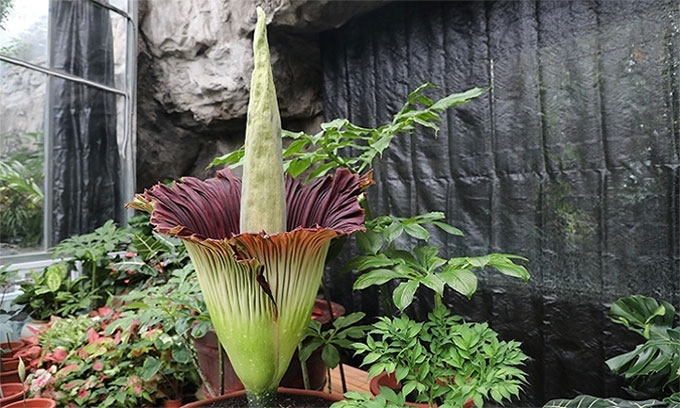Three Corpse Flowers Bloom at Beijing Botanical Garden, Offering Rare Research Opportunities for Scientists.
The corpse flower blooms in the exhibition greenhouse. (Video: Beijing National Botanical Garden)
On July 20, a massive corpse flower bloomed next to another large flower of the same species in the exhibition greenhouse at the Beijing National Botanical Garden, according to CGTN. This is the second corpse flower to bloom recently in the garden. The first flower bloomed on July 6, and the third flower is expected to bloom soon. Researchers say this is the first opportunity to observe three corpse flowers blooming simultaneously in an artificial environment.
The corpse flower, also known as Titan arum, is extremely rare. It is one of the world’s most foul-smelling flowers. This plant only blooms 3 to 4 times during its lifetime, and each flower lasts less than 2 days. The corpse flower is native to the tropical rainforests of Sumatra, Indonesia. It has the largest unbranched flower stalk in the world, with the exhibition flower reaching a height of 1.68 meters.

When blooming, the corpse flower releases gas containing over 100 chemicals, creating a smell similar to rotting meat.
Due to the enormous size of the corpse flower and its high nutrient consumption, its blooming period lasts only about 48 hours. When it blooms, the corpse flower releases gas containing over 100 chemicals, producing a smell reminiscent of decaying flesh. It also generates heat during blooming, with the flower stalk reaching a temperature of about 36 degrees Celsius, close to human body temperature. All changes in odor, color, and temperature are designed to attract insects such as flies and beetles for pollination.
The blooming period of the corpse flower at the Beijing National Botanical Garden allows researchers to examine this plant more closely. They have recorded the pollen production activity of the male flower. Researching the blooming process of the corpse flower is crucial for the botanical garden.
The corpse flower is listed as vulnerable in the International Union for Conservation of Nature (IUCN) Red List. The rainforests of Sumatra are being devastated due to the demand for palm and wood products. Indonesia has lost approximately 72% of its tropical rainforest. Studying the reproductive mechanisms of plants is essential for finding ways to conserve this species. The corpse flower also holds significant economic and scientific research value. Its tuber contains a large amount of glucomannan, which can be widely used in the food, pharmaceutical, cosmetic, chemical, and biological industries.


















































